自动机理论、语言和计算导论:笔记
Automata Theory, Languages, and Computation
中间有一大部分内容,都因为笔记本意外关闭,没有保存而丢失了,实在是可惜。但也回不到那时候的劲头去再敲一遍笔记了
- Automata Theory, Languages, and Computation
- Sec2 Finite Automata
- Sec3 Regular Expressions and Languages
- Sec4 Properties of Regular Languages
- Sec5 Context-Free Grammar and Context-Free Languages
- Sec6 Pushdown Automata
- Sec7 Properties of Context-Free Languages
Sec2 Finite Automata
2.1 Informal Picture of Finite Automata
- The Ground Rules
- The Protocol
- Enabling the Automata to Ignore Actions
- The Entire System as an Automaton
- Product Automaton
2.2 Deterministic Finite Automata
2.2.1 Definition of DFA
-
Formal definition:
\[A = (Q, \Sigma, \delta, q_0, F) \]- A finite set of states, often denoted \(Q\)
- A finite set of input symbols, often denoted \(\Sigma\)
- A transition function that takes as arguments a state and an input symbol and returns a state The transition function will commonly be denoted \(\delta\)
- A start state one of the states in \(Q\), denoted \(q_0\)
- A set of final or accepting states \(F\). The set \(F\) is a subset of \(Q\)
2.2.3 Simpler Notations for DFA’s
-
Transition diagram

-
Transition table
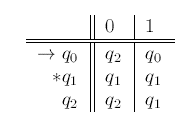
2.2.4 Extending the Transition Function to Strings
- Assume that \(w = xa\)\[\hat{\delta}(q,w) = \delta(\hat{\delta}(q,x),a) \]
2.2.5 The Language of a DFA
- Language:\[L(A) = \{w,|\hat{\delta}(q_0,w)\in F\} \]
2.3 Nondeterministic Finite Automata
2.3.2 Formal Definition of NFA’s
-
Definition by set:
\[A = (Q,\Sigma,\delta,q_0,F) \]- \(Q,\Sigma,q_0,F\) is the same as DFA’s, representing finite set, input symbols, start state and accepting states set respectively.
- \(\delta\), the transition function returns a subset of \(Q\).
2.3.3 Extended Transition Function
-
Definition:
-
BASIS:
\(\hat{\delta}(q,\epsilon)={q}\). -
INDUCTION:
Suppose \(w\) is of the form \(w=xa\), where \(a\) is the final symbol of \(w\). Also suppose that \(\hat{\delta}(q,x)={p_1,p_2,\dots,p_k}\).
Let:\[\bigcup_{i=1}^k\delta(p_i,a) = \{r_1,r_2,\dots,r_m\} \]Then \(\hat{\delta}(q,w)={r_1,r_2,\dots,r_m}\).
-
2.3.4 The Language of an NFA
- Definition:\[L(A) = \{w|\hat{\delta}(q_0,w)\cap F \ne\empty\} \]
2.3.5 Equivalence of Deterministic and Nondeterministic Finite Automata
-
Subset construction
\(NFA\ N = (Q_N,\Sigma,\delta_N,q_0,F_N)\) --> \(DFA\ D=(Q_D,\Sigma,\delta_D,\{q_0\},F_D)\)
Such that \(L(D)=L(N)\)-
Steps:
-
\(Q_D\) is the set of subsets of \(Q_N\)
-
\(F_D\) is the set of subsets \(S\) of $ Q_N$ such that $S\cap F_N\ne\empty $
-
For each set \(S\subseteq Q_N\) and for each input symbol \(a\) in \(\Sigma\)
\[\delta_D(S,a) = \bigcup_{p\ in\ S}\delta_D(p,a) \]
-
-
2.3.6 A Bad Case for the Subset Construction
-
Worst Case for Subset Construction
If we have to track every state in NFA, there will be \(2^n\) states for DFA. -
The Pigeonhole Principle
2.5 Finite Automata With Epsilon-Transitions
2.5.2 The Formal Notation for an ε-NFA
-
Notation:
\[A=(Q,\Sigma,\delta,q_0,F) \]- all components have their same interpretation as for an NFA except that \(\delta\) is now a function that takes as arguments:
- A state in \(Q\), and
- A member of \(\Sigma \cup\{\epsilon\}\) , that is either an input symbol or the symbol \(\epsilon\) .
We require that \(\epsilon\) the symbol for the empty string cannot be a member of the alphabet \(\Sigma\), so no confusion results.
- all components have their same interpretation as for an NFA except that \(\delta\) is now a function that takes as arguments:
2.5.3 Epsilon-Closures
- Definition of Epsilon-Closure:
- BASIS:
State $q $ is in \(ECLOSE(q)\) - INDUCTION:
If state \(p\) is in \(ECLOSE(q)\) and there is a transition from state \(p\) to state \(r\) labeled \(\epsilon\), then \(r\) is in \(ECLOSE(q)\).
More precisely, if \(\delta\) is the transition function of the \(\epsilon-NFA\) involved, and $p $ is in \(ECLOSE(q)\), then \(ECLOSE(q)\) also
contains all the states in \(\delta(p,\epsilon)\)
- BASIS:
2.5.4 Extended Transitions and Languages for ε-NFA’s
- Languages:\[L(E) = \{w|\hat{\delta}(q_0,w)\cap F \ne\empty\} \]
2.5.5 Eliminating Epsilon-Transition
Let \(E=(Q_E,\Sigma,\delta_E,q_0,F_E)\), then the equivalent \(DFA\)
-
Step:
-
\(Q_D\) is the set of subsets of \(Q_E\). More precisely, all accessible states of \(D\) are \(\epsilon-closed\) subsets of \(Q_E\).
-
\(q_D=ECLOSE(q_0)\)
-
\(F_D\) is those sets of states that contain at least one accepting state of \(E\). That is
\[F_D = \{S|S\ is\ in\ Q_D\ and\ S\cap F_E\ne \empty\} \] -
\(\delta_D(S,a)\) is computed, for all \(a\) in \(\Sigma\) and sets \(S\) in \(Q_D\) by:
- Let \(S=\{p_1,p_2,\dots,p_k\}\)
- Compute \(\bigcup_{i=1}^{k}\delta_E(p_i,a)\); Let this set be \(\{r_1,r_2,\dots,r_m\}\)
- Then \(\delta_D(S,a)=ECLOSE(\{r_1,r_2,\dots,r_m\})\)
-
Sec3 Regular Expressions and Languages
3.1 Regular Expressions
3.1.1 The Operators of Regular Expressions
-
union:
\[L\cup M\ \ \ \ \ or\ \ \ \ \ L +M \] -
concatenation:
\[LM \ \ \ \ \ or \ \ \ \ L \cdot M \] -
closure(or star, or Kleene closure)
\[L^* = \bigcup_{i\ge 0}L^i \]- Note:\[\empty^* = \{\epsilon\} \]
- Note:
3.2 Finite Automata and Regular Expressions
3.2.1 From DFA’s to Regular Expressions
-
Theorem: If \(L=L(A)\) for some DFA, then there is a regular expression R such that L=L(R).
-
Proof:
Assume the Regular Expression that we construct is \(R_{ij}^{(k)}\) whose language is the set of strings \(w\) such that \(w\) is the label of a path from state \(i\) to state \(j\) in A, and that path has no intermediate node whose number is greater than \(k\). (no constraint that \(i\) and/or \(k\) be less than or equal to \(k\)).
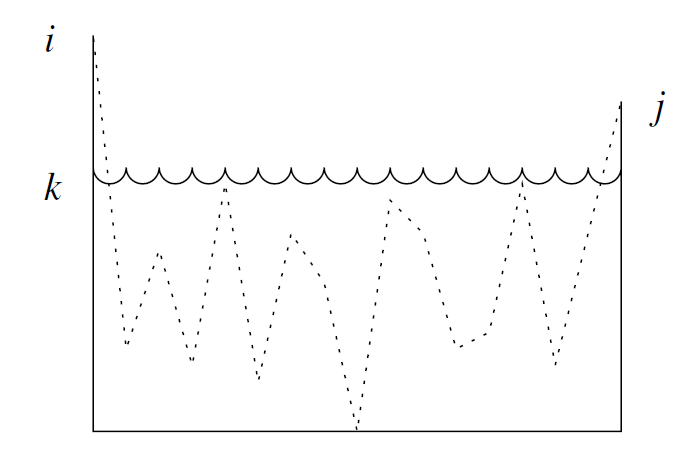
-
BASIS:
The basis is \(k=0\). Since all state are numbered 1 or above, so there is no intermediate state at all. Only 2 conditions satisfy.- An arc from node i to node j.
- A path of length 0 that consists of only some node i.
Then we have the following constructions:
- If there is no such symbol a, then \(R^{(0)}_{ij}=\empty\).
- If there is exactly one such symbol a, then \(R_{ij}^{(0)}=a\).
- If there are symbols \(a_1,a_2,\dots,a_k\), that label arcs from state i to state j, then \(R_{ij}^{(0)}=a_1+a_2+\dots+a_k\)
- If i=j. Then we have a self-loop on i node. In the above situation, we can add label \(\epsilon\) to the above Regular Expressions.
-
INDUCTION:
Suppose there is a path from state i to state j that goes through no state higher than k There are two possible cases to consider-
The path does not go through state k at all:
In this case, the label of the path is in the language of $ R^{(k-1)}_{ij} $ -
The path goes through state k at least once:
 \[R_{ik}^{(k-1)}(R_{kk}^{(k-1)})^*R_{kj}^{(k-1)} \]
\[R_{ik}^{(k-1)}(R_{kk}^{(k-1)})^*R_{kj}^{(k-1)} \]
-
-
Q.E.D
-
-
3.2.2 Converting DFAs to Regular Expressions by Eliminating States
-
Figure:
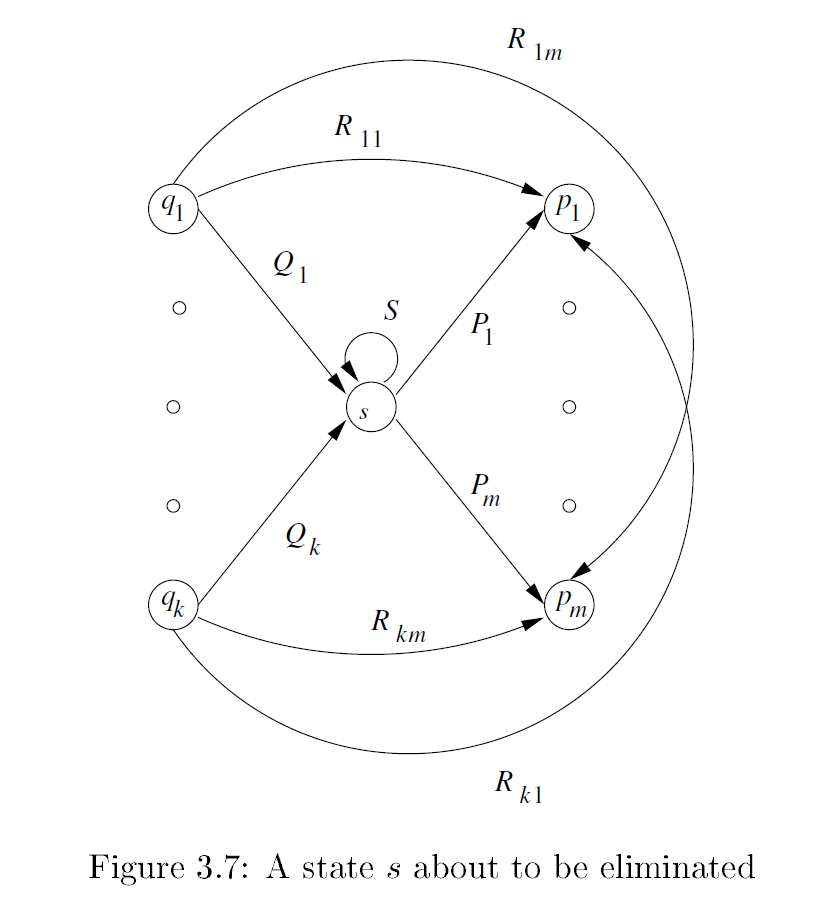
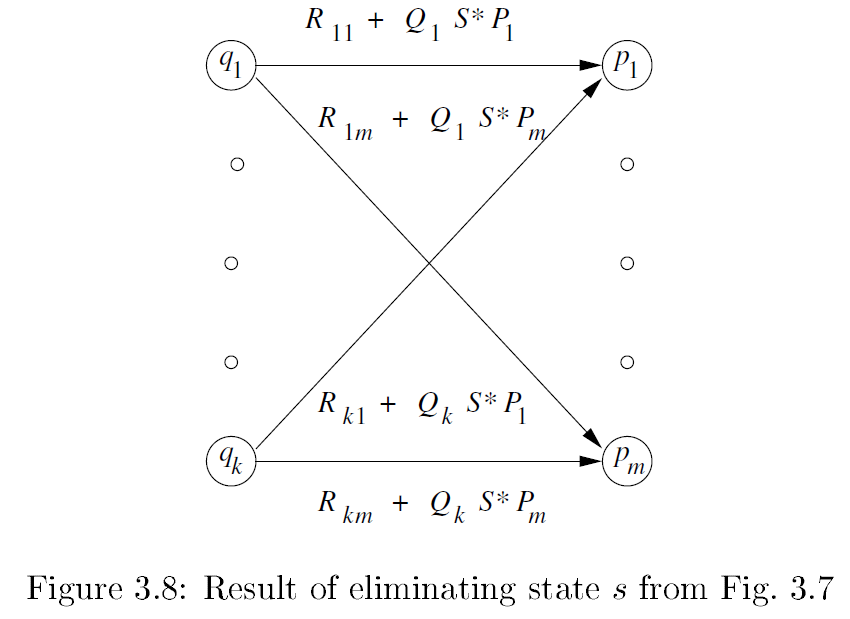
-
Strategy:
-
For each accepting state q, apply the above reduction process to produce an equivalent automaton with regular expression labels on the arcs.
-
If \(q\ne q_0\). We have a generic two-state automaton.
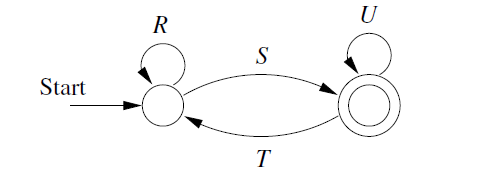
The Regular expression is:
\[(R+SU^*T)^*SU^* \] -
If the start state is also an accepting state. We will have a one-state automaton.
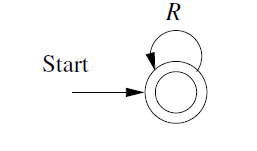
The RE is:
\[R^* \]
-
-
Example:
Key idea: Eliminating the intermediate state.
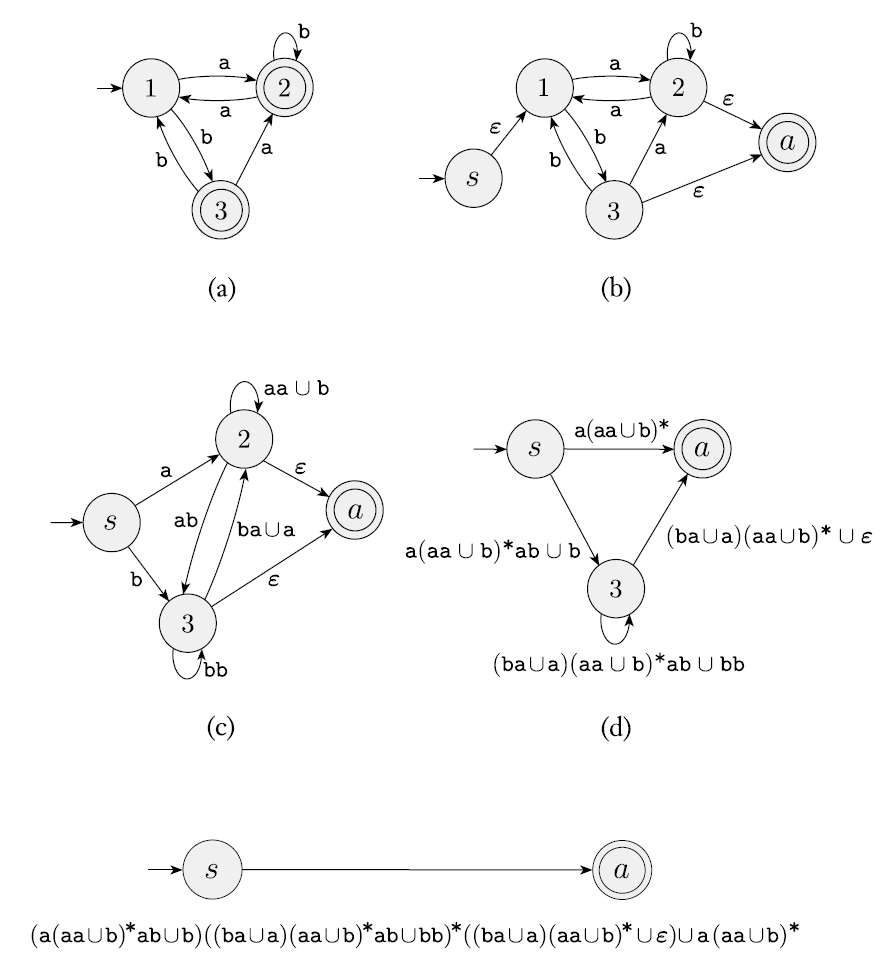
3.2.3 Converting Regular Expressions to Automata
-
Prove by Structural Induction on R:
-
BASIS:
-
\(\{\epsilon\}\)
-
\(\empty\)
-
-
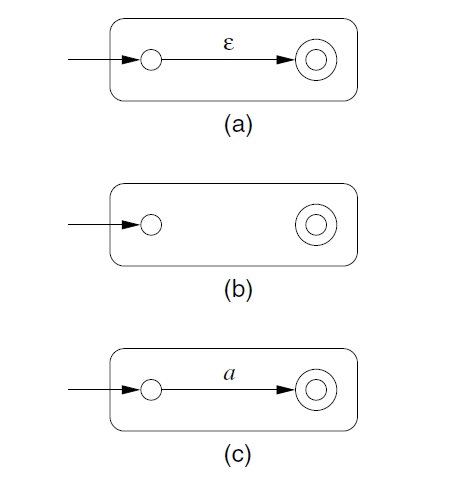
-
INDUCTION:
-
\(R+S\).
The language is \(L(R)\cup L(S)\)
-
\(RS\)
Concatenation. -
\(R^*\)
Closure -
\((R)\)
Unchanged.
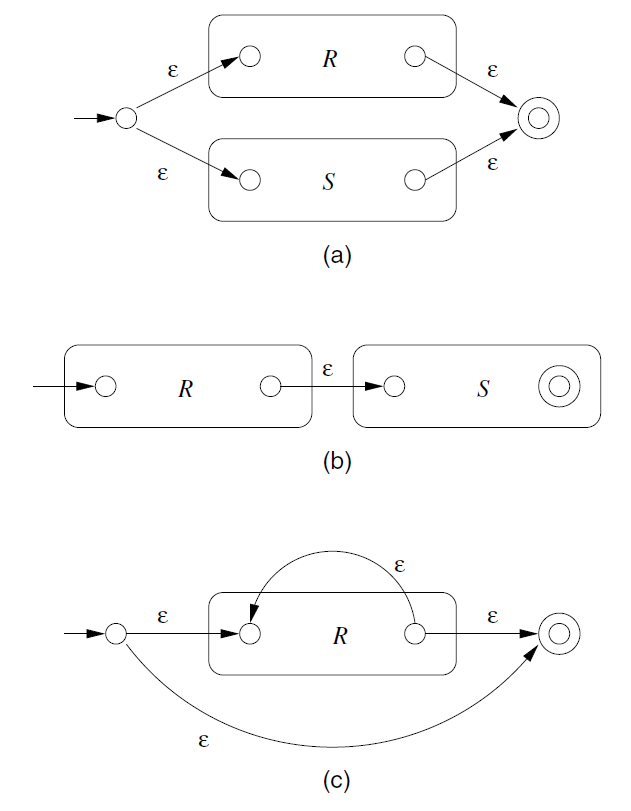
-
3.4 Algebraic Laws for Regular Expressions
-
Simplification of RE:
-
\[\empty R = R \empty=\empty \]
\(\empty\) is an annihilator for concatenation. It results in itself when concatenated.
-
\[\empty+R = R+\empty=R \]
\(\empty\) is the identity for union. It results in the other expression whenever it appears in a union.
-
\[\epsilon L = L\epsilon = L \]
\(\epsilon\) is identity for concatenation.
-
Distributive Laws:
\[L(M+N)=(M+N)L = LM+LN \] -
The Idempotent Law:
\[L+L=L \] -
Laws Involving Closures:
-
\((L^*)^* = L^*\)
-
\(\empty^*=\epsilon\)
-
\(\epsilon^*=\epsilon\)
-
\(L^+=LL^*\)
-
\(L^*=L^++\epsilon\)
-
\(L?=\epsilon+L\)
-
\((L+M)^*=(L^*M^*)^*\)
-
-
-
Discovering Laws for Regular Expressions:
- Theorem:
Let E be a regular expression with variables \(L_1,L_2,\dots,L_m\).
Form concrete regular expression \(C\) by replacing each occurrence of \(L_i\) by the symbol \(a_i\) for \(i=1,2,\dots, m\)
Then for any languages \(L_1,L_2,\dots,L_m\), every string \(w\) in \(L(E)\) can be written \(w=w_1w_ 2\cdots w_k\) where each \(w_i\) is in one of the languages, say \(L_{j_{i}}\) and the string \(a_{j_1}a_{j_2}\cdots a_{j_k}\) is in the language$ L(C)$.
- Theorem:
Sec4 Properties of Regular Languages
4.1 Pumping Lemma for Regular Languages
- The Pumping lemma for Regular Languages:
Let $ L$ be a regular languages. Then there exists a constant \(n\)(which depends on \(L\)) such that for every string \(w\) in \(L\) such that \(|w|\ge n\), we can break \(w\) into three strings \(w=xyz\), such that:- \(y\ne \epsilon\)
- \(|xy|\le n\)
- For all \(k\ge 0\), the string \(xy^kz\) is also in \(L\).
- Proof:
Using Pigeonhole Principle. Then deduct a contradiction.

4.2 Closure Properties of Regular Languages
- Summary of the principal closure properties for regular languages:
Two Languages:- Union
- Intersection
- Complement
- Difference
- Reversal
- Closure(star)
- Concatenation
- Homomorphism(substitution of strings for symbols)
- Inverse Homomorphism
4.2.1 Closure of Regular Languages Under Boolean Operations
-
Closure Under Union
- Proof:
Suppose \(L = L(R), M=L(S)\)
Then: \(L\cup M=L(R+S)\)
- Proof:
-
Closure Under Complementation
- Find a regular expression for its complement as follows
- Convert the regular expression to an \(\epsilon-NFA\)
- Convert that \(\epsilon- NFA\) to a \(DFA\) by the subset construction
- Complement the accepting states of that \(DFA\)
- Turn the complement \(DFA\) back into a regular expression.
- Proof:
Let \(L=L(A)\) for some \(DFA\ A=(Q,\Sigma,\delta,q_0,F)\). Then \(\bar{L} = L(B)\). .Then the accepting states of \(A\) have become nonaccepting states of \(B\), and vice versa. Then \(w\) is in \(L(B)\) if and only if \(\hat{\delta}(q_0,w)\) is in \(Q-F\), which occurs if and only if \(w\) is not in \(L(A)\).
- Find a regular expression for its complement as follows
-
Closure Under Intersection
-
Prove 1:
\[L\cap M = \overline{\overline{L}\cup\overline{M}} \] -
Prove 2:
Product Construction:- Formal:\[A = (Q_L\times Q_M,\Sigma,\delta,(q_L,q_M),F_L\times F_M) \]where \(\delta((p,q),a)=(\delta_L(p,a),\delta_M(q,a))\)
- Formal:
-
-
Closure Under Difference:
- Prove:\[L-M=L\cap \overline{M} \]
- Prove:
4.2.2 Reversal
-
Construction:
- Reverse all the arcs in the transition diagram for A
- Make the start state of A be the only accepting state for the new automaton
- Create a new start state \(p_0\) with transitions on \(\epsilon\) to all the accepting states of A
-
Proof:
- BASIS:
If E is \(\epsilon, \empty\) or some symbol \(a\). Then the reversal of it is itself. - INDUCTION:
- \(E=E_1+E_2 \Rightarrow E^R=E_1^R+E_2^R\)
- \(E=E_1E_2\Rightarrow E^R=E_2^RE_1^R\)
- \(E=E_1^*\Rightarrow E^R=(E_1^R)^*\)
- BASIS:
4.2.3 Homomorphisms
A string homomorphism is a function on strings that works by substituting a particular string for each symbol
-
Proof:
Key idea: Prove \(h(L(E))=L(h(E))\)-
BASIS:
If \(\epsilon,\empty\) or \(a\). Obviously -
INDUCTION:
-
Union:
Suppose \(E=F+G\). Then \(h(E)=h(F)+h(G)\).
Then, \(L(h(E))=L(h(F))\cup L(h(G))\).By inductive hypothesis, \(h(L(E)) = h(L(F))\cup h(L(G)) = L(h(E))\)
-
Concatenation
-
Closure
-
-
4.2.4 Inverse Homomorphisms
-
Tricks: Note that we can prove the contrapositive of the statement we set out to prove!
-
Theorem:
If \(h\) is a homomorphism from alphabet \(\Sigma\) to alphabet \(T\) and $L $ is a regular language over \(T\) then \(h^{-1}(L)\) is also a regular language -
Proof:
核心思想: 设a是B中的输入字符 只要A接受h(a)=w,一连串后,到达A的接受状态,则B也到达接受状态 则构造性证明完毕 (B读入字符,相当于A读入一个字符串)Starts with a DFA A for L:
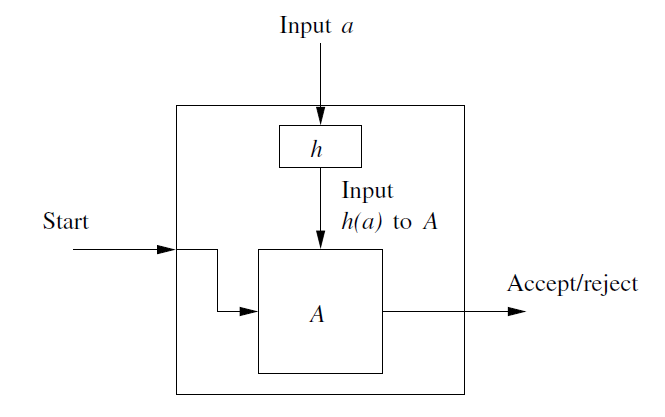
Formally, let \(L\) be \(L(A)\), where $DFA\ A = (Q,T,\delta,q_0,F). $. Define a \(DFA\):
\[B=(Q,\Sigma,\gamma,q_0,F) \]where transition function \(\gamma\) is constructed by the rule:
\[\gamma(q,a)=\hat{\delta}(q,h(a)) \](h(a) could be ε) We can easily prove that \(\hat{\gamma}(q_0,w)=\hat{\delta}(q_0,h(w))\).Since the accepting states of A and B are the same, \(B\) accepts \(w\) if and only if \(A\) accepts \(h(w)\)
- Mooc 证明
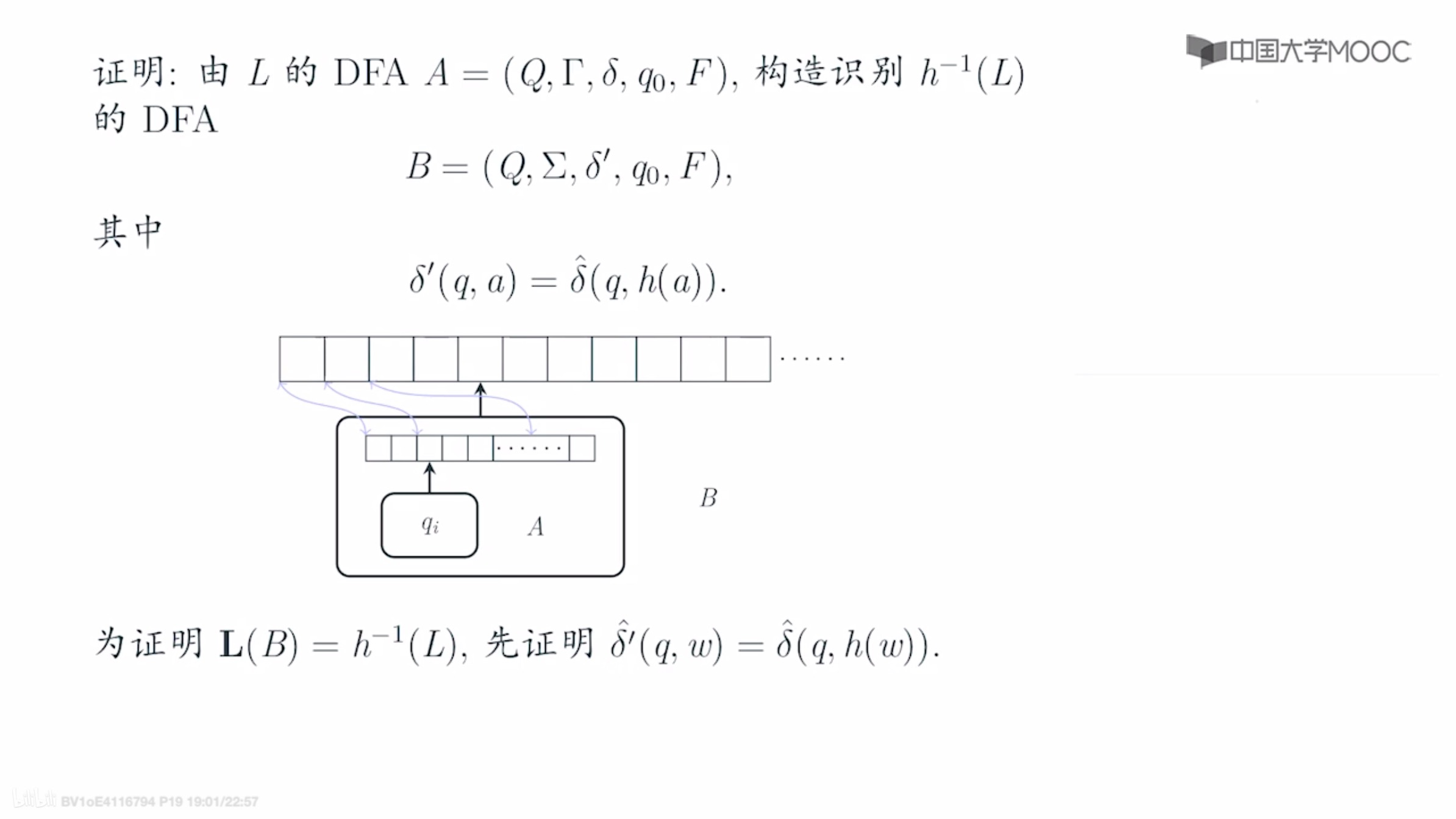

- Mooc 证明
4.3 Decision Properties of Regular Languages
4.3.1 Converting Among Representations
- Converting NFA’s to DFA’s
- Computing the closure of \(\epsilon\) takes \(O(n^3)\). Or \(O(n^2)\)
- The state of DFA can be \(2^n\). After optimizing,we can reduce the time complexity to \(O(n^3)\) (reachable set)
- DFA-to-NFA Conversion
\(O(n)\) - Automaton-to-Regular-Expression Conversion
Double exponential. Because each is built from four expressions of the previous round - Regular-Expression-to-Automaton Conversion
\(O(n)\)
4.4 Equivalence and Minimization of Automata
4.4.1 Testing Equivalence of States
-
State \(p\) and \(q\) are equivalent if :
- For all input string \(w\), \(\hat{\delta}(p,w)\) is an accepting state if and only if \(\hat{\delta}(q,w)\) is an accepting state.
-
State \(p\) and \(q\) are not equivalent, we say they are distinguishable. That is:
- state \(p\) is distinguishable from state \(q\) if there is at least one string \(w\) such that one of \(\hat{\delta}(p,w)\) and \(\hat{\delta}(q,w)\) is accepting, and the other is not accepting.
-
Table-Filling Algorithm
-
BASIS:
If \(p\) is an accepting state and \(q\) is nonaccepting, then the pair \(\{p,q\}\) is distinguishable
-
INDUCTION:
Let \(p\) and \(q\) be states such that for some input symbol \(a,r=\delta(p,a)\) and \(s=\delta(q,a)\) are a pair of states known to be distinguishable
-
4.4.3 DFA Minimization
- First, eliminate any state that cannot be reached from the start state
- Then, partition the remaining states into blocks, so that all states in the same block are equivalent, and no pair of states from different blocks are equivalent
Sec5 Context-Free Grammar and Context-Free Languages
Sec6 Pushdown Automata
6.3 Equivalence of PDA’s and CFG’s
6.3.1 From Grammars to Pushdown Automata
-
Idea:
To have the PDA simulate the sequence of left sentential forms that the grammar uses to generate a given terminal string \(w\) -
Formal Description:
Let \(G=(V,T,Q,S)\) be a CFG, construct the PDA P that accepts L(G) by empty stack as follows.\[P=(\{q\},T,V\cup T,\delta,q,S) \]where transition function \(\delta\) is defined by:
-
For each variable A:
\[\delta(q,\epsilon,A) = \{(q,\beta)|A\rightarrow\beta\ is\ a\ production\ of\ G\} \] -
For each terminal \(a, \delta(q,a,a)=\{(q,\epsilon)\}\)
-
-
We can easily prove the construction by using Chomsky Normal Form
6.3.2 From PDA’s to Grammars
-
Idea:
Construction of an equivalent grammar uses variables each of which represents an event consisting of:- The net popping of some symbol X from the stack \(X\), and
- A change in state from some \(p\) at the beginning to \(q\) when $X $ has finally been replaced by \(\epsilon\) on the stack.
We represent such a variable by the composite symbol \([pXq]\)
-
Theorem:
Let \(P=(Q,\Sigma,\Gamma,\delta,q_0,Z_0)\) be a PDA Then there is a context free grammar \(G\) such that \(L(G)= N(P)\) -
Proof:
-
Construction of \(G=(V,\Sigma,R,S)\)
-
Where the set of variables V consists of:
- The special symbol \(S\) which is the start symbol, and
- All symbols of the form \([pXq]\) where \(p\) and \(q\) are states in \(Q\), and \(X\) is a stack symbol, in \(\Gamma\)
-
The productions of \(G\) are as follows:
-
For all states \(p, G\) has the production \(S \rightarrow [q_0Z_0p]\)
-
Let \(\delta(q,a,X)\) contain the pair \((r,Y_1,Y_2,\dots,Y_k)\), where
- \(a\) is either a symbol in \(\Sigma\) or \(a=\epsilon\)
- \(k\) can be any number, including 0, in which case the pair is \((r,\epsilon)\)
Then for any lists of states \(r_1,r_2,\dots,r_k, G\) has the production:
\[[qXr_k]\rightarrow a[rY_1r_1][r_1Y_2r_2]\dots[r_{k-1}Y_kr_k] \]
-
-
-
We can prove the correctness by INDUCTION.
\[[qXp]\Rightarrow^*w, if\ and\ only\ if\ (q,w,X)\vdash^*(p,\epsilon,\epsilon) \]思想: 为了在栈中完整的弹出一个栈符号,需要从输入带上,消耗掉一部分输出串。 那么,消耗掉的这部分输入串,与栈中弹出的栈符号,是一种对应关系。 如果我们将栈中的栈符号,看成是一个变元, 那么就相当于,从这个栈符号的变元,可以派生出被消耗掉的那部分输出串 步骤如下: 0. 先对开始符号定义产生式,到所有的状态,模拟空栈接受PDA 1. 从栈符号X替换为Y1...Yn, 状态从q变成p(中间的转台为r1,...,rn) 2. 我们将这动作看成,先派生出一个a,然后让[pY1r1][r1Y2r2]...[rn-1Ynrn]分别派生剩下的PDA的输入串 3. 然后我们可以用归纳,就能证明充分必要性 注意,需要构造Q的n次方个产生式
-
6.4 Deterministic Pushdown Automata
6.4.1 Definition of a Deterministic PDA
- We define a \(PDA\ P=(Q,\Sigma,\Gamma,\delta,q_0,Z_0,F)\) to be a deterministic (DPDA), if and only if the following conditions are met:
- \(\delta(q,a,X)\) has at most one member for any \(q\) in \(Q\), \(a\) in \(\Sigma\) or \(a=\epsilon\), and \(X\) in \(\Gamma\)
- If \(\delta(q,a,X)\) is nonempty, for some a in \(\Sigma\), then \(\delta(q,\epsilon,X)\) must be empty
6.4.2,3 Regular Languages, CFG, and DPDA
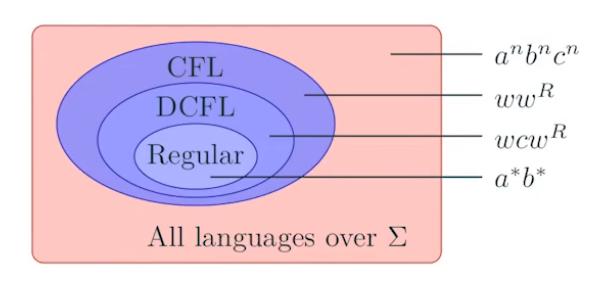
6.4.4 DPDA’s and Ambiguous Grammars
- Theorem:
If \(L=N(P)\) for some DPDA P, then L has an unambiguous context-free grammar
Sec7 Properties of Context-Free Languages
7.1 Normal Forms for Context-Free Grammars
- Preliminary Simplifications:
- Eliminate Useless Symbols
- \(\epsilon-productions\)
- Eliminate unit productions
7.1.1 Eliminating Useless Symbols
- Identifying the 2 things a symbol has to be able to do:
- We say \(X\) is generating if \(X\Rightarrow^*w\) for some terminal string \(w\). Every terminal is generating.
- We say \(X\) is reachable if there is a derivation \(S\Rightarrow^*\alpha X\beta\) for some \(\alpha\) and \(\beta\)
- Order:
- First we check Generating.
- Then we check Reachable.
7.1.3 Eliminating ε-Productions
-
Nullable:
A variable A is nullable if \(A\Rightarrow^*\epsilon\). -
Method:
If A is nullable, then whenever A appears in a production body, say \(B\rightarrow CAD\), A might derive ε. We make 2 versions of the production:- Without A in the body, say \(B\rightarrow CD\).
- Cannot allow A to derive ε. Say \(B\rightarrow C\hat{A}D\). and \(\hat{A}\)s are the productions of \(A\rightarrow \hat A\)
-
Steps:
- Find the nullable symbols
- Consider the production R, that contains nullable symbols
- Add the productions in R, which contains all permutation and combination of nullable symbols
7.1.4 Eliminating Unit Production
-
Unit production:
is a production of the form A->B, where both A and B are variables. -
Find unit pair:
- BASIS: (A,A) is a unit pair for any variable A.
- INDUCTION: Suppose we have determined that (A,B) is a unit pair, and B->C is a production, where C is a variable, then (A,C) is a unit pair.
-
Elimination:
- Find all the unit pairs of G
- For each unit pair (A,B), add to \(P_1\) all the productions A->α, where B->α is a non-unit production in P. Note that A=B is possible; in that way, \(P_1\) contains all the non-unit productions in P
7.1.5 Chomsky Normal Form
-
The order of Eliminations:
- Eliminate ε-productions
- Eliminate unit productions
- Eliminate useless symbols
-
Definition of Chomsky Normal Form:
The CFL without ε has a grammar G in which all productions are in one of 2 simple form, either:
- A->BC
- A->a, where a is a terminal.
-
Construction:
- Arrange that all bodies of length or more consist only of variables
- Break bodies of length, or more into a cascade of productions, each with a body consisting of two variables
7.2 The Pumping Lemma for Context-Free Languages
- The Advantage of Using CNF: Turn parse trees into binary trees.
7.2.2 Statement of the Pumping Lemma
-
Lemma:
Let L be a CFL. Then there exists a constant n such that if z is any string in L such that |z| is at least n, then we can write z=uvwxy, subject to the following conditions:
- |vwx|<=n. That is, the middle portion is not too long.
- vx!=ε. Since v and x are the pieces to be “pumped”. This condition says that at least one of the strings we pump must not be empty.
- For all i >= 0. \(uv^iwx^iy\) is in L.
-
Proof of CFG-Pumping Lemma:
Using pigeonhole principle:
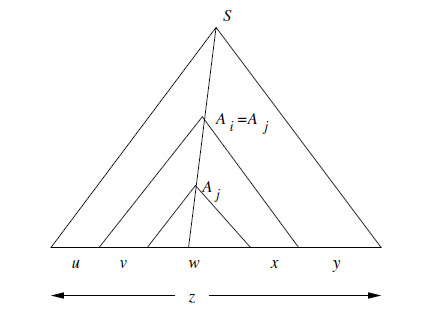
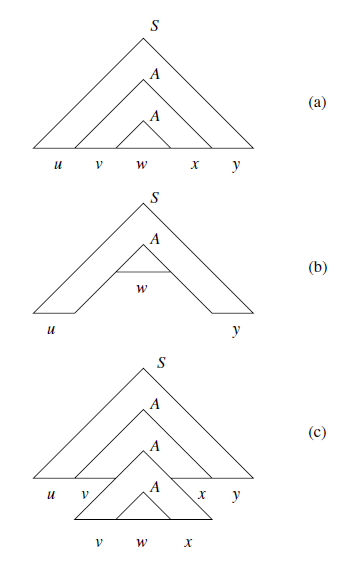
7.3 Closure Properties of Context-Free Languages
7.3.1 Substitutions
-
Theorem:
If \(L\) is a context free language over alphabet \(\Sigma\), and \(s\) is a substitution on \(\Sigma\) such that s(a) is a CFL for each a in \(\Sigma\), then s(L) is a CFL -
Proof:
Say G=(\(V,\Sigma,P,S\)) for L and \(G_a=(V_a,T_a,P_a,S_a)\) for each a in \(\Sigma\)We construct a new grammar G’=(V’,T’,P’,S) for s(L), as follows
-
V’ is the union of V and all the \(V_a's\) for a in \(\Sigma\)
\[V'=V\cup (\bigcup_{a\in T}V_a) \] -
T’ is the union of all the \(T_a's\) for a in \(\Sigma\)
\[T'=\bigcup_{a\in T}T_a \] -
P’ consists of:
- All productions in any \(P_a\), for a in \(\Sigma\)
- The productions of P,but with each terminal a in their bodies replaced by \(S_a\) everywhere a occurs
-
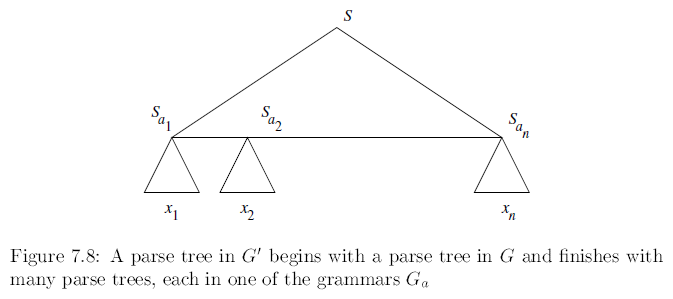
7.3.2 Applications of the Substitution Theorem
-
Theorem:
The context free languages are closed under the following operations- Union
- Concatenation
- Closure(*), or positive closure
- Homomorphism
s(a) = {h(a)}, -> , h(L) = s(L)
7.3.3 Reversal
-
CFL’s are closed under reversal
-
Proof:
Let L=L(G) for some CFL G=(V,T,P,S). Construct \(G^R=(V,T,P^R,S)\), where \(P^R\) is the reverse of each production in P. That is, if A->a is a production of G, the A->\(a^R\) is a production of \(G^R\).
7.3.4 Intersection
-
The CFLs are not closed under 2 CFG’s intersection.
-
Theorem:
If L is a CFL and R is a regular language, then \(L\cap R\) is a CFL. -
Proof:
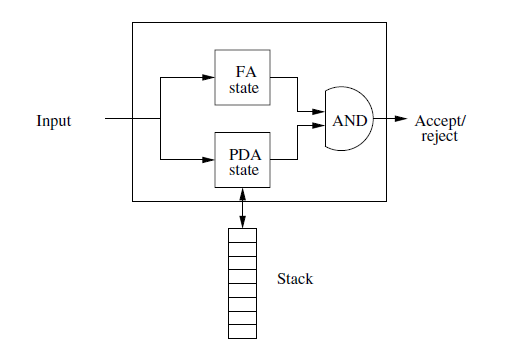
-
Formally:
Let\[P=(Q_P,\Sigma,\Gamma,\delta_P,q_P,Z_0,F_P) \]be a PDA that accepts L by final state, and let:
\[A=(Q_A,\Sigma,\delta_A,q_A,F_A) \]ne a DFA for R. Construct PDA:
\[P'=(Q_P\times Q_A, \Sigma,\Gamma,\delta,(q_P,q_A),F_P\times F_A) \]where \(\delta((q,p),a,X)\) is defined to be the set of all pairs \(((r,s),\gamma)\) such that:
- \(s=\hat{\delta}_A(p,a)\), and
- Pair \((r,\gamma)\) is in \(\delta_P(q,a,X)\)
-
-
Another Theorems:
If we have CFL L, L1 and L2, and regular languages R:
-
L-R is CFL:
- Proof:\[L-R=L\cap\bar{R} \]
- Proof:
-
\(\bar{L}\) is not necessarily a CFL:
- Proof:
Because \(\bar{L}\) is also Context-Free. And we have:\[L_1\cap L_2 =\overline{\overline{L_1}\cup\overline{L_2}} \]So intersection is closed, too. We have a Contradiction.
- Proof:
-
L1-L2 is not necessarily Context-Free
If we choose L1 to be \(\Sigma^*\). Then L1-L2 is \(\overline{L2}\)
-
7.3.5 Inverse Homomorphism
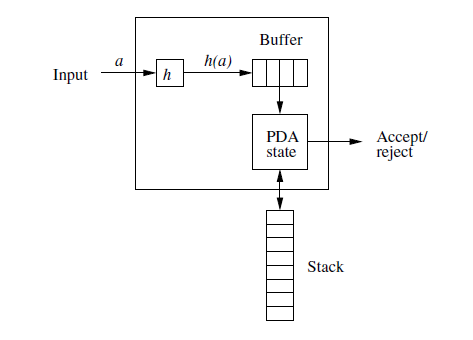
-
Theorem:
If L is CFL on \(\Delta\), h is homomorphism from \(\Sigma\) to \(\Delta^*\). Then, \(h^{-1}(L)\) is CFL, too.-
Proof:
Let \(PDA\ P=(Q,\Delta,\Gamma,\delta,q_0,Z_0,F)\), \(L(P)=L\). Constructing PDA of \(L(P')=h^{-1}(L)\) :\[P'=(Q',\Sigma,\Gamma,\delta',[q_0,\bar\epsilon],Z_0,F\times \{\bar{\epsilon}\}) \]In the states of P’, we use buffer, temporarily save the homomorphism string h(a) of symbol \(a\in \Sigma\).
-
\(Q'\subset Q\times \Delta^*\): \(\bar x\) in state \([q,\bar x]\) is buffer:
-
Let \(q\in Q\), then we define \(\delta'\):
-
\(\forall [q,\bar\epsilon]\in Q\times \{\bar\epsilon\},\forall a\in \Sigma, \forall X\in \Gamma\):
\[\delta'([q,\bar\epsilon],a,X)=\{([q,h(a)],X)\} \] -
If \(\delta(q,\bar a, X)=\{(p_1,\beta_1),(p_2,\beta_2),\dots,(p_k,\beta_k)\}\), then:
\[\delta'([q,\overline{ax}],\epsilon,X)=\{([p_1,\bar x],\beta_1),([p_2,\bar x],\beta_),\dots,([p_k,\bar x],\beta_k)\} \]Where \(\bar a\in \Delta \cup\{\bar \epsilon\}\), \(\bar x\) is the suffix of some h(a)
-
-
-

